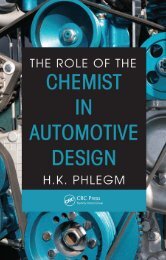Lightweight Electric/Hybrid Vehicle Design
Lightweight Electric/Hybrid Vehicle Design
Lightweight Electric/Hybrid Vehicle Design
You also want an ePaper? Increase the reach of your titles
YUMPU automatically turns print PDFs into web optimized ePapers that Google loves.
8 <strong>Lightweight</strong> <strong>Electric</strong>/<strong>Hybrid</strong> <strong>Vehicle</strong> <strong>Design</strong><br />
than conventional designs and can be charged and discharged rapidly. However, there is a trick to<br />
achieving this. Most batteries are made up of ‘rectangular’ arrays of cells so it is no wonder that<br />
the temperature of the cells varies with position in the stack. To charge a battery quickly it is vital<br />
to keep the cells at an even temperature. Consequently it is necessary to liquid cool the cells so as<br />
to obtain best performance and long life. Other points worthy of note are that batteries work best<br />
when hot; 40°C is ideal for lead–acid. The battery electrolyte is just the place to dump waste heat<br />
from the motor/engine/fuel cell.<br />
Nickel–cadmium batteries offer better performance than lead–acid but are double the cost per<br />
Wh of storage at present and sealed versions are limited to 10 Ah but larger units are under<br />
development. The best nickel–cadmium units available at present are the SAFT STM/STH series.<br />
Sealed lead–acid and aqueous nickel–cadmium cells have peak power in W/kg of 90 and 180,<br />
with Wh/kg values being 35 and 55 respectively.<br />
In terms of safety, long series strings of aqueous batteries are not a good idea. The leakage<br />
from tracking is high and they are very dangerous to work on. Consequently batteries should<br />
be of sealed construction with no more than 110 V in a single string. Ideally, the maximum<br />
voltage should be 220 V DC, that is +/− 110 V to ground arranged as two separate strings<br />
with a centre tap, so that no more than 110 V appears on a connector, with respect to ground,<br />
Fig. 1.5.<br />
There is an opening in the market place for a low cost 2 pole, 220 V, 300 A remote-control<br />
circuit breaker to act as battery isolator with 5 kA short-circuit capacity. However, there is a<br />
problem with earthing the centre tap of the battery as one may need an isolating transformer<br />
in the battery charger. Consequently, in many of the new schemes proposed in the USA, a<br />
different route is implemented which is used in trolley buses – the all-insulated system. In<br />
most of these schemes, large capacity batteries are used (15–30 kWh) at a typical nominal<br />
voltage of 300 V. This will vary from 250 V fully discharged to 375 V at the end of charging.<br />
The electrical system is fully insulated from earth. During charging, the mains supply can be<br />
either centre tap ground or one-end ground. In the centre tap ground (typical USA situation,<br />
6.6 kV<br />
60 Hz<br />
100 V<br />
100 V<br />
100 V<br />
Method of<br />
connecting<br />
battery to<br />
ensure string<br />
does not<br />
exceed 100 V<br />
Fig. 1.5 Battery connections and earthing.<br />
1<br />
2<br />
110 V<br />
B<br />
R<br />
~ ~<br />
Ground<br />
European<br />
system<br />
0 V<br />
110 V<br />
<strong>Vehicle</strong><br />
power<br />
converter<br />
Battery<br />
-180 V<br />
American<br />
system Balanced voltage to earth<br />
~<br />
+180 V<br />
230 V<br />
Y<br />
<strong>Vehicle</strong><br />
power<br />
converter<br />
100% ripple<br />
with respect to<br />
vehicle chassis<br />
SYSTEM INSULATED<br />
AND SCREENED FROM<br />
VEHICLE CHASSIS<br />
SYSTEM<br />
INSULATED<br />
AND SCREENED<br />
FROM<br />
VEHICLE CHASSIS<br />
Battery







